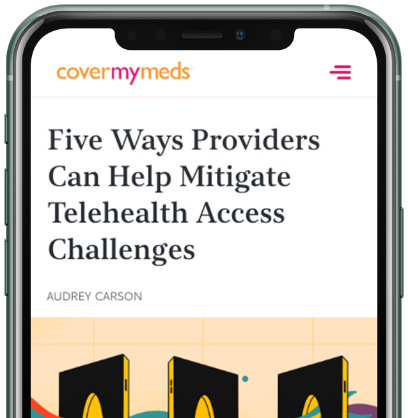How Pharmacies Can Prepare for Medicare Fair Price (MFP) Compliance
New Inflation Reduction Act rules are approaching fast. Here’s how pharmacies can get ahead — and how CoverMyMeds is helping.

As part of the Inflation Reduction Act (IRA), the Medicare Drug Price Negotiation Program — also known as Medicare Fair Price (MFP) – is set to go into effect in January 2026. First announced in August 2023, this program was designed to lower out-of-pocket drug costs for Medicare beneficiaries. But while the policy is patient-focused at its core, the path to implementation introduces significant operational and financial complexity for pharmacies — those on the front lines of patient care.
With the first 10 MFP drugs already announced and The Centers for Medicare & Medicaid Services (CMS) final guidance in place, pharmacies now face a rapidly approaching deadline to adapt reimbursement processes, reconfigure systems and manage new administrative workflows. The changes affect everything from pharmacy inventory management and claims processing to patient communication and cash flow. Ensuring seamless, patient-centered integration without overhauling pharmacy infrastructure will be essential to maintaining access and continuity of care.
Recent industry discussions, including a CoverMyMeds-hosted webinar featuring leaders from McKesson and EY-Parthenon, have underscored just how much is at stake for pharmacies and how quickly they’ll need to act. The key takeaway: now is the time for pharmacies to prepare — and CoverMyMeds is helping streamline the path to MFP readiness.
What Is MFP and What Does It Mean for Pharmacies?
MFP refers to the negotiated price Medicare will pay for select high-cost drugs. For pharmacies, this change introduces a new pricing tier, which will influence:
- Dispensing practices
- Reimbursement timelines
- Cash flow dynamics
- Patient access
- Data exchange and workflow
According to CMS guidelines, pharmacies will dispense the drug at full acquisition cost and then receive a manufacturer-paid refund based on the negotiated MFP price. While this structure aims to reduce patient out-of-pocket costs, it creates a payment delay and reconciliation burden for pharmacies.
“Pharmacies are still expected to pay the front payment for these drugs,” said Fauzea Hussain, Vice President of Public Policy at McKesson, on a recent webinar. “They're going to be waiting still at minimum, three to four weeks for the anticipated MFP refund.”
What Pharmacies Will Be Up Against
While MFP aims to lower out-of-pocket costs for Medicare beneficiaries, its rollout brings new pressures for pharmacies, especially when it comes to day-to-day operations. From cash flow strain to claims reconciliation, the demands are complex and time-sensitive. So what should pharmacies be watching most closely?
1. Cash Flow Strain
Pharmacies must front the cost of MFP-covered medications, waiting a minimum of three to four weeks for reimbursement. According to the National Community Pharmacists Association (NCPA), this could require the average community pharmacy to float over $27,000/month in 2026, adding up to more than $500 million/month industry-wide when factoring in long-term care pharmacies and others.National Community Pharmacists Association, Independent Pharmacies Reluctant to Stock Drugs in Medicare Negotiation Program, New Survey Shows, Oct. 15, 2024.
2. Uncertainty Around Stocking Decisions
More than 90% of community pharmacies are considering not stocking MFP drugs due to financial pressure.National Community Pharmacists Association, NCPA Releases Member Summary on Medicare Price Negotiation Final Guidance, Oct. 24, 2024. This could create access gaps for patients and impact continuity of care. Pharmacies may need to evaluate their financial strategies and consider alternative solutions to mitigate the impact of stocking decisions on patient access.
3. New Claims and Reconciliation Workflows
Pharmacies must now interact with CMS-designated data and payment facilitators, validate transactions, and reconcile refunds through a ledger-based system.The Inflation Reduction Act: What to Watch Following the First Round of Medicare Price Negotiations, CoverMyMeds Webinar, July 2025. “Manufacturers and pharmacies can use the system as a virtual reconciliation system, similar to wholesaler chargebacks,” noted Hussain.Fauzea Hussain, VP, Public Policy, McKesson. Webinar panelist remarks. The IRA: What to Watch, July 2025. This introduces unfamiliar administrative steps and potential delays.
4. Reimbursement Variability
Manufacturers can calculate MFP refunds using either wholesale acquisition cost (WAC) minus MFP or actual acquisition cost (AAC) minus MFP.CMS Final Guidance on the Medicare Drug Price Negotiation Program, 2025. Pharmacies will need to account for these differences in their reconciliation and accounting processes. This variability can lead to inconsistencies in cash flow and financial planning, requiring more robust pharmacy accounting practices to manage these fluctuations effectively.
5. Patient Confusion
Pharmacists will be on the front lines of explaining why “lower drug prices” don’t always translate to immediate or consistent out-of-pocket savings, especially as plan design, tier placement and rebate strategies vary.Beardsley, John. Webinar moderator commentary. The IRA: What to Watch, CoverMyMeds, July 2025.
Clear communication and patient education will be crucial in managing expectations and ensuring patients understand the nuances of the new pricing structure. Pharmacies should prepare their staff with the necessary tools and information to help anticipate Medicare pricing discussions and address patient concerns effectively.
What Pharmacies Should Do Now
Pharmacies don’t have the luxury of waiting. With MFP’s go-live date approaching, preparing now is critical to minimize disruption, maintain financial stability and protect patient access. These proactive steps can help pharmacies stay ahead of the curve:
1. Start Operationalizing MFP Workflows Today
CMS has already finalized guidance for transaction facilitators, data standards and refund cycles. Waiting to prepare will only compress the timeline to compliance. Pharmacies will need to make significant workflow adjustments quickly. From redesigning administrative processes to integrating new systems, these pivots must be implemented in a short window to avoid disruptions once MFP goes live.
2. Assess Technology Readiness
Evaluate whether existing pharmacy systems can handle drug-level MFP tracking at the National Drug Code (NDC) 9/11 level, as well as customized refund configurations and reconciled workflows across Actual Acquisition Cost (AAC) and Wholesale Acquisition Cost (WAC)-based refund logic.
3. Plan for Margin Volatility
Build flexibility into inventory and pricing strategies. Work with suppliers and vendors to anticipate cost shifts and reimbursement timelines.
4. Train Pharmacy Teams
Equip staff with up-to-date messaging, FAQs and escalation pathways to support patient conversations and reduce friction at the point of care.
How CoverMyMeds Helps Prepare Pharmacies for MFP
To support pharmacies through this complex transition, CoverMyMeds is introducing a dedicated MFP refund estimation product as part of our comprehensive pharmacy technology platform. We anticipate rolling this new technology out in early 2026. Capabilities will include:
- Drug-Level Customization: Configure MFP refund calculations at the NDC 9/11 level, enabling precise tracking and financial planning.
- Customer-Specific Configuration: Refund logic can be customized to align with a pharmacy’s acquisition cost model (AAC or WAC).
- Real-Time Visibility: Real-time estimations of expected MFP refunds, empowering pharmacies to better manage their receivables and mitigate cash flow stress.
- Workflow Integration: Designed to seamlessly connect with existing CMM solutions and payer systems, the tool will support fast, efficient adjudication and reconciliation, without overhauling your tech stack.
Why This Matters Now
Pharmacies are navigating unprecedented financial and operational complexity, and MFP is just one part of the larger story.
Ultimately, every participant in the patient journey has a common goal: to get the right treatment to the right patient at the right time, explained John Beardsley, Senior Vice President of Corporate Strategy at CoverMyMeds, during a recent webinar. If all players can commit to this going forward, both patients and the overarching system benefits.
Pharmacies that act early, adopting purpose-built tools and modernizing their workflows, will be best positioned to stay compliant, maintain financial health, and protect patient access. Proactive preparation not only minimizes the risk of disruption as MFP takes effect, but also equips pharmacy teams to navigate new reimbursement complexities with greater clarity and control. With the right technology and operational alignment, pharmacies can transform policy-driven change into a strategic advantage that reinforces their role in delivering timely, patient-centered care.
By establishing MFP processes well ahead of the deadline, pharmacies can also free up time, resources, and attention to focus on other pressing industry challenges. This forward-thinking approach promotes smoother day-to-day operations, stronger financial resilience, and more consistent patient experiences, while others may still be scrambling to catch up.
Let’s Navigate MFP Together
As a healthcare technology leader connecting pharmacy, pharma, provider, and payer workflows, CoverMyMeds is committed to helping our partners prepare for the IRA’s full impact. Check back for more.
Ready to get started?
Complete this form or contact your CoverMyMeds account manager to learn how our platform supports MFP preparedness.
The latest healthcare insights, floated right to your inbox.



